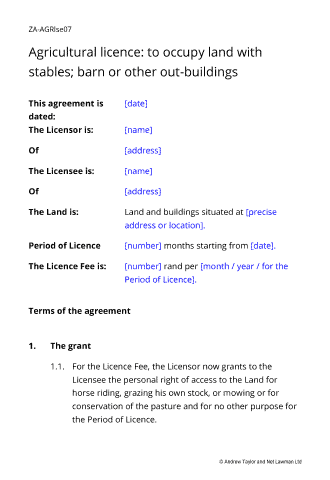Agricultural licence

Document overview


- Length:5 pages (1125 words)
- Available in:
 Microsoft Word DOCX
Microsoft Word DOCX Apple Pages
Apple Pages RTF
RTF

If the document isn’t right for your circumstances for any reason, just tell us and we’ll refund you in full immediately.

We avoid legal terminology unless necessary. Plain English makes our documents easy to understand, easy to edit and more likely to be accepted.

You don’t need legal knowledge to use our documents. We explain what to edit and how in the guidance notes included at the end of the document.

Email us with questions about editing your document. Use our Lawyer Assist service if you’d like our legal team to check your document will do as you intend.

Our documents comply with the latest relevant law. Our lawyers regularly review how new law affects each document in our library.
About this agricultural licence
This is a licence to occupy agricultural land and/or buildings for non-business use. Typical uses might be for keeping horses or other animals, personal storage of vehicles or other possessions, and recreational riding (for example, in an arena).
This document has been drawn for land of an agricultural nature, where care of the land by the licensee is important to the owner. The property could be a building (such as stables, a barn or a workshop) or a set of buildings, or land of any sort including fields, woodland and orchards, or a combination.
The law relating to this licence
Land law that applies to agricultural tenancies. The law in this document is common law, giving you greater flexibility to decide your own terms with your licensee.
Important to the licence remaining as such, and not becoming a lease (giving more rights to the tenant) is that the landlord retains access to the land at all times and remains in control of and responsible for services (such as electricity and water) and larger maintenance works. Limiting the use of the land, the term of the licence (to less than a year, ideally 6 months and renewed as necessary), the times of access, and particularly what the licensee may do will help the agreement be seen as a licence rather than a lease.
When to use this agricultural licence
You should use this document to license agricultural land and/or buildings to an individual only. Using the land for business purposes (such as a livery) requires an Agricultural lease: private grazing or non-agricultural business use. If the land is to be used for agricultural business (such as farming), then a Farm lease agreement is required. It may be possible to use a grazing agreement if the licensee is a farmer using the land solely to graze his livestock.
It is important when granting a licence that the term is short. If you are letting on a long term (more than 9 months) then you should use an Agricultural lease: private grazing or non-agricultural business use.
Otherwise, the licence can be used for:
- Any sort of agricultural land or buildings
- Any use agreed, except business and residential
Document features and contents
The advantages of using an agricultural licence agreement rather than a lease are that the landlord has no requirement to give advance notice to access the land or to end the agreement. This agreement is comprehensive and has been written specifically for licensing agricultural land. It includes:
- Details of the parties, the licence fee and the land
- Permitted use of the land
- Payment: how and when, including interest
- Condition and repair
- Restrictions on the licensee
- Rubbish removal and contamination
- Access for both parties
- Transfer and assignment
- Termination: how and when
- Other legal provisions

Recent reviews
Choose the level of support you need
Document Only
This document
Detailed guidance notes explaining how to edit each paragraph
Lawyer Assist
This document
Detailed guidance notes explaining how to edit each paragraph
Unlimited email support - ask our legal team any question related to completing the document
- Review of your edited document by our legal team including:
- reporting on whether your changes comply with the law
- answering your questions about how to word a new clause or achieve an outcome
- checking that your use of defined terms is correct and consistent
- correcting spelling mistakes
- reformatting the document ready to sign
All rights reserved
